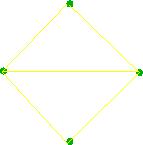Problem of the Month-March and April

|
|
The above is a picture of the Petersen graph, a famous
mathematical object made out of ten ``vertices'' (points) and fifteen ``edges'' (line segments) with three edges
emanating from each vertex. Here we have drawn the graph
in a way that all the edges do not have the same length. Question 1 Using co-ordinate geometry or whatever verify that such a drawing can be achieved with exactly equal edges ? Consequently now, imagine that this is a physical system made out of rigid rods of unit length, with certain rods attached at their end points (as in the picture) by pivots. Thus, if not constrained by the other rods, each rod would be free to rotate about either of its two ends. The whole system is constrained to lie in the plane. Definition : We would say that such a system is rigid if, whatever forces you may apply on it (along its plane), you can not move its constituent parts relative to each other (without breaking the system!): you can only move the system as a whole. For instance, the square
 is not rigid since it can be distorted to a rhombus. But the system  is rigid. (But note that if you were allowed to use the third dimension, even the second system would not be rigid: you could then fold it along the common edge of the two triangles.) Now the problem of the month is: Is the Petersen graph rigid? |
|
Solution was provided by Sucharit Sarkar and can be found here. |